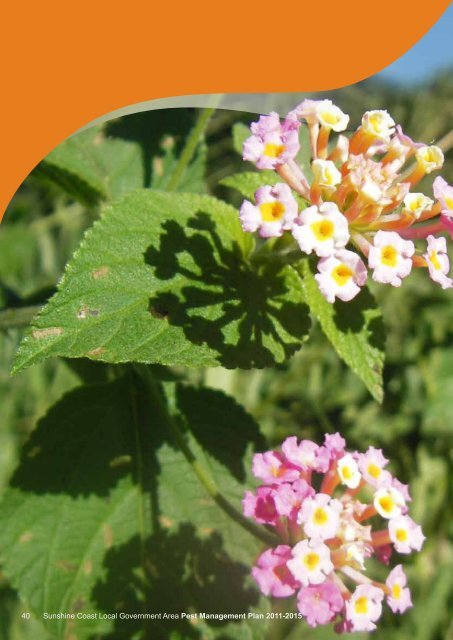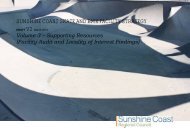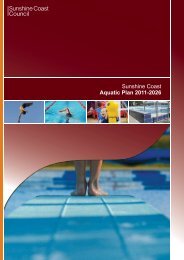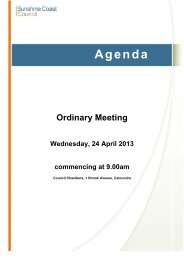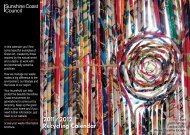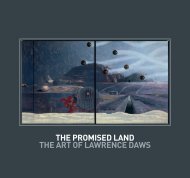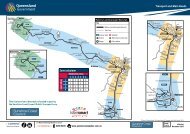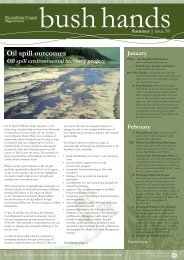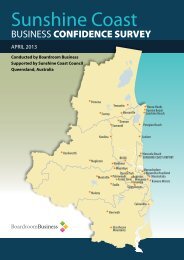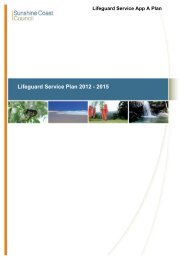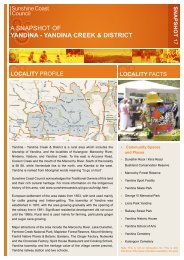40 Sunshine Coast Local Government Area Pest Management Plan ...
40 Sunshine Coast Local Government Area Pest Management Plan ...
40 Sunshine Coast Local Government Area Pest Management Plan ...
You also want an ePaper? Increase the reach of your titles
YUMPU automatically turns print PDFs into web optimized ePapers that Google loves.
<strong>40</strong> <strong>Sunshine</strong> <strong>Coast</strong> <strong>Local</strong> <strong>Government</strong> <strong>Area</strong> <strong>Pest</strong> <strong>Management</strong> <strong>Plan</strong> 2011-2015
SECTION 26<br />
Background<br />
Strategic<br />
Program<br />
(<strong>Pest</strong> Species)<br />
lantana (Lantana camara)
6 Strategic Program (<strong>Pest</strong><br />
Species)<br />
6.1 Overview<br />
<strong>Pest</strong> species of significance for the <strong>Sunshine</strong><br />
<strong>Coast</strong> are listed in five management categories.<br />
These categories have been developed to<br />
give direction in relation to the management of<br />
particular species.<br />
Factors that have been considered in<br />
determining the management of a species<br />
include the threat it poses, its distribution, the<br />
declared status of the pest, and the achievability<br />
of control. A thorough and objective assessment<br />
of these matters demands extensive population<br />
and distribution data which, to a large degree,<br />
was unavailable or incomplete for the <strong>Sunshine</strong><br />
<strong>Coast</strong> area. Therefore, the initial categorisation<br />
of pest species was undertaken based on the<br />
extensive collective knowledge and experience<br />
of the stakeholders who contributed to the<br />
development of the plan.<br />
This plan is intended to be a living document<br />
that is reviewed and updated regularly to<br />
take account of changing circumstances and<br />
growing knowledge of pest population dynamics<br />
across the <strong>Sunshine</strong> <strong>Coast</strong>. It is intended<br />
that a current version of the category lists be<br />
maintained on Council’s website.<br />
The management categories recognised under<br />
the plan are:<br />
► Under ► Surveillance (Section 6.2)<br />
► Broad ► Control (Section 6.3)<br />
► Strategic ► <strong>Management</strong> (Section 6.4)<br />
► <strong>Local</strong> ► Control (Section 6.5)<br />
► General ► Environmental <strong>Pest</strong>s (Section 6.6)<br />
The Strategic Program (<strong>Pest</strong> Species) identifies a<br />
number of broad strategic actions that is intended<br />
to contribute to achieving the desired outcomes.<br />
These strategic actions relate to the management<br />
of particular species and groups of pests.<br />
For each strategic action, one or more<br />
measures of success are identified. These<br />
measures represent milestones that intend to<br />
be used to evaluate the effectiveness of the<br />
plan and its implementation. The stakeholders<br />
that have responsibility for delivering each<br />
strategic action are also identified.<br />
This section must be read in conjunction with<br />
the implementation plan, which describes<br />
the component projects and actions that<br />
combine to deliver the strategic actions.<br />
The implementation plan provides additional<br />
detail about stakeholder responsibilities and<br />
timeframes for the delivery of the listed actions.<br />
The management objectives, species lists and<br />
strategic actions relating to each category are<br />
described in the following sections.<br />
Below is a list of stakeholders relevant to the<br />
strategic actions in Section 6.<br />
Stakeholders<br />
BQ<br />
CG<br />
CPAG<br />
Industry<br />
L<br />
NRM<br />
QGLM/<br />
Utilities<br />
Department of Employment,<br />
Economic Development<br />
and Innovation (Biosecurity<br />
Queensland)<br />
A collective reference to the many<br />
community conservation and<br />
environmental groups that have a<br />
role in pest management<br />
Community pest action group<br />
Includes nursery industry (incl.<br />
market plant stalls), natural areas<br />
management industry, Forestry<br />
<strong>Plan</strong>tations Qld etc.<br />
Landowners<br />
Natural resource management<br />
groups, including SEQ Catchments<br />
and Burnett Mary Regional Group<br />
Queensland <strong>Government</strong> land<br />
managers – agencies and<br />
government owned corporations<br />
that manage land, including<br />
Department of Transport and Main<br />
Roads, Queensland Rail, SEQ<br />
Water, Energex etc.<br />
QPWS Queensland <strong>Government</strong> –<br />
Department of Environment<br />
and Resource <strong>Management</strong><br />
(Queensland Parks and Wildlife<br />
Service)<br />
SCC<br />
RI<br />
<strong>Sunshine</strong> <strong>Coast</strong> Council<br />
Research institutions e.g.<br />
Commonwealth Scientific and<br />
Industrial Research Organisation<br />
42 <strong>Sunshine</strong> <strong>Coast</strong> <strong>Local</strong> <strong>Government</strong> <strong>Area</strong> <strong>Pest</strong> <strong>Management</strong> <strong>Plan</strong> 2011-2015
6.2 <strong>Management</strong> Category: Under Surveillance<br />
<strong>Management</strong> objective<br />
The objective of this category is to provide for the early detection of any new incursions of these<br />
species and to allow for rapid response to be taken. Should any new incursions of these species<br />
be discovered, the species would be immediately included under the Broad Control category.<br />
Species included<br />
All declared species that are not currently known to occur on the <strong>Sunshine</strong> <strong>Coast</strong> are included in<br />
this category. Species identified by bold text are known to occur in neighbouring local government<br />
areas. The likelihood of these high alert species being brought into the <strong>Sunshine</strong> <strong>Coast</strong> is<br />
considered to be increased due to their current proximity.<br />
6.2.1 Table 4 Strategic actions<br />
Strategic actions<br />
P1<br />
P2<br />
P3<br />
Conduct regular surveys with<br />
particular focus on high risk<br />
locations and past infestation<br />
sites and investigate reports<br />
of suspected presence of<br />
Under Surveillance species.<br />
Immediately elevate any<br />
newly detected Under<br />
Surveillance species to<br />
Broad Control category.<br />
Develop species specific<br />
communication and<br />
education materials for high<br />
alert species and conduct<br />
targeted communication and<br />
education programs in high<br />
risk locations.<br />
Measures of success<br />
Any new incursions discovered before pest<br />
becomes established<br />
Control measures are taken before pest becomes<br />
established<br />
New incursions are reported before pest becomes<br />
established<br />
Who is<br />
responsible<br />
SCC, BQ,<br />
QPWS,<br />
QGLM, NRM<br />
BQ, SCC,<br />
CPAG<br />
SCC, BQ,<br />
CPAG, NRM,<br />
CG<br />
<strong>Sunshine</strong> <strong>Coast</strong> <strong>Local</strong> <strong>Government</strong> <strong>Area</strong> <strong>Pest</strong> <strong>Management</strong> <strong>Plan</strong> 2011-2015 43
6.2.2 <strong>Pest</strong> species - Under surveillance<br />
Scientific name Common name Status Nearby location*<br />
Alternanthera philoxeroides alligator weed C1 MRC<br />
Andropogon gayanus gamba grass C2<br />
Anoplolepis gracilipes yellow crazy ant C1 MRC<br />
Austracris guttulosa spur-throated locust C2<br />
Bassia scoparia syn. Kochia scoparia kochia C1<br />
Cabomba spp. other than C.caroliniana cabomba, fanwort C1<br />
Capra hircus goat (not domestic goats) C2<br />
Chortoicetus terminifera Australian plague locust C2<br />
Chromolaena spp. Siam weed C1<br />
Chrysanthemoides monilifera subsp.<br />
monilifera<br />
Boneseed<br />
Clidemia hirta Koster’s curse C1<br />
Cylindropuntia fulgida<br />
Cylindropuntia imbricata<br />
Cylindropuntia spinosior<br />
Cylindropuntia spp. and hybrids<br />
other than C. spinosior, C. fulgida and C.<br />
imbricata<br />
cholla cactus, coral cactus,<br />
devil's rope pear, snake<br />
cactus<br />
cholla cactus<br />
C2<br />
C1<br />
Eichhornia azurea anchored water hyacinth C1<br />
Elephantopus mollis tobacco weed C2<br />
Equisetum spp. horsetails C1<br />
Gmelina elliptica badhara bush C1<br />
Gymnocoronis spilanthoides Senegal tea C1 MRC<br />
Harrisia martinii syn. Eriocereus martinii<br />
Harrisia tortuosa<br />
Harrisia pomanensis syn. Cereus<br />
pomanensis<br />
harrisia cactus C2 MRC<br />
Harungana madagascariensis harungana C3<br />
Heterotheca grandiflora telegraph weed C2<br />
Jatropha gossypiifolia belly-ache bush C2 SRC<br />
Lagarosiphon major lagarosiphon C1<br />
Limnocharis flava limnocharis, yellow burrhead C1<br />
Locusta migratoria migratory locust C2<br />
Lycium ferocissimum African boxthorn C2 MRC, SRC, GRC<br />
Miconia spp. miconia C1<br />
Mimosa diplotrycha var. diplotrycha giant sensitive plant C2 SRC<br />
Mimosa pigra mimosa pigra C1<br />
Myrica faya myrica, candleberry myrth C1<br />
44 <strong>Sunshine</strong> <strong>Coast</strong> <strong>Local</strong> <strong>Government</strong> <strong>Area</strong> <strong>Pest</strong> <strong>Management</strong> <strong>Plan</strong> 2011-2015
6.2.2 <strong>Pest</strong> species - Under surveillance<br />
Scientific name Common name Status Nearby location*<br />
Myriophyllum spicatum Eurasian water milfoil C1<br />
Nassella neesiana Chilean needle grass C1<br />
Nassella tenuissima Mexican feather grass C1 MRC<br />
Nassella trichotoma serrated tussock C1<br />
Neptunia oleracea<br />
Neptunia plena<br />
Opuntia spp. other than O. ficus-indica,<br />
O. stricta, O. aurantiaca, O. monacantha,<br />
O. tomentosa and O. streptacantha<br />
water mimosa<br />
prickly pear<br />
Parkinsonia aculeata parkinsonia C2 SRC<br />
Piper aduncum piper, spiked pepper C1<br />
Pithecellobium dulce madras thorn C1<br />
Prosopis glandulosa<br />
Prosopis pallida<br />
Prosopis velutina<br />
Prosopis spp. and hybrids other than<br />
P. glandulosa, P. pallida and P. velutina<br />
mesquites<br />
mesquites<br />
Salix matsudana tortured willow C3<br />
Salvinia spp. other than S. molesta salvinia C1<br />
Senna hirsute<br />
Senna obtusifolia<br />
Senna tora<br />
C1<br />
C1<br />
C2<br />
C1<br />
sicklepods C2 GRC<br />
Sesbania punicea red sesbania C1<br />
Stratiotes aloides water soldiers C1<br />
Striga spp. (other than native species) witch weeds C1<br />
Tamarix aphylla athel pine C3<br />
Thunbergia annua<br />
thunbergia, annual<br />
thunbergia<br />
Trapa spp. floating water chestnuts C1<br />
Various – as prescribed<br />
Various spp.<br />
class 1 pest animals<br />
prohibited pets<br />
Ziziphus mauritiana chinee apple C2<br />
Ziziphus spina-christi Christ’s thorn C1<br />
C1 - Class 1 declared species C2 - Class 2 declared species C3 - Class 3 declared species<br />
(as defined under the Land Protection Act)<br />
* GRC Gympie Regional Council area<br />
MRC Moreton Bay Regional Council area<br />
SRC Somerset Regional Council area<br />
C1<br />
<strong>Sunshine</strong> <strong>Coast</strong> <strong>Local</strong> <strong>Government</strong> <strong>Area</strong> <strong>Pest</strong> <strong>Management</strong> <strong>Plan</strong> 2011-2015 45
6.3 <strong>Management</strong> Category: Broad Control<br />
<strong>Management</strong> objective<br />
The objective of this category is to work towards the eventual eradication of the listed species<br />
from the <strong>Sunshine</strong> <strong>Coast</strong>. This requires cooperation between stakeholders and active coordinated<br />
management of the species wherever it occurs, irrespective of land tenure or use. It should be<br />
noted that this could take many years to achieve and both short and long term targets may be<br />
determined over time.<br />
Species included<br />
All Class 1 declared species that are currently known to occur on the <strong>Sunshine</strong> <strong>Coast</strong> are included<br />
in this category. Several additional declared and non-declared species that have been determined<br />
to be feasible targets for eradication across the <strong>Sunshine</strong> <strong>Coast</strong> are also included.<br />
6.3.1 Table 5 Strategic actions<br />
Strategic actions<br />
Measures of success<br />
Who is<br />
responsible<br />
P4<br />
Establish baseline of current<br />
distributions of Broad Control<br />
species by conducting<br />
targeted surveys of known<br />
and suspected infestation<br />
zones.<br />
Distributions of Broad Control species are known<br />
and mapped<br />
Existing infestation zones are identified<br />
SCC, BQ,<br />
QGLM All<br />
stakeholders<br />
P5<br />
Develop species specific<br />
communication and<br />
education materials<br />
and conduct targeted<br />
communication and<br />
education programs to<br />
engage landholders in<br />
known infestation zones.<br />
Landholders are active in managing Broad Control<br />
species in known infestation zones.<br />
BQ, SCC,<br />
CPAG,<br />
Industry<br />
(nondeclared<br />
species)<br />
P6<br />
Establish local area<br />
partnership groups<br />
including landholders in<br />
known infestation zones<br />
to undertake cooperative<br />
control action, and<br />
coordinate action with<br />
neighbouring Councils where<br />
populations cross local<br />
government boundaries.<br />
Known infestations of Broad Control species<br />
are actively managed with the aim of eventual<br />
eradication.<br />
SCC, BQ,<br />
landowners<br />
P7<br />
Undertake seasonal surveys<br />
of infestation zones to<br />
monitor effectiveness of<br />
control measures.<br />
Progress towards eradication of Broad Control<br />
species is known<br />
SCC, BQ,<br />
landowners<br />
46 <strong>Sunshine</strong> <strong>Coast</strong> <strong>Local</strong> <strong>Government</strong> <strong>Area</strong> <strong>Pest</strong> <strong>Management</strong> <strong>Plan</strong> 2011-2015
6.3.2 <strong>Pest</strong> species - Broad control<br />
Scientific name Common name Status<br />
Annona glabra pond apple C2<br />
Asparagus asparagoides bridal creeper C1<br />
Cecropia spp. Mexican bean tree C1<br />
Chrysanthemoides monilifera subsp. rotunda bitou bush C1<br />
Cryptostegia grandiflora rubber vine C2<br />
Gleditsia spp. including cultivars and varieties honey locust C1<br />
Harrissia spp. syn. Eriocereus spp. other than<br />
H. martinii, H. tortuosa and H. pomanensis syn.<br />
Cereus pomanensis<br />
harrisia cactus<br />
C1<br />
Hedychium flavescens yellow ginger C1<br />
Hygrophila costata hygrophila, glush weed C1<br />
Ludwigia peruviana peruvian primrose C1<br />
Mikania spp. mikania vine C1<br />
Parthenium hysterophorus parthenium C2<br />
Pereskia aculeata<br />
Praxelis clematidea<br />
Pueraria montana var. lobata syn. P. lobata, P.<br />
triloba<br />
Salix spp. other than S. babylonica,<br />
S. humboldtiana syn. S. chilensis, S. matsudana,<br />
S. x calodendron and S. x reichardtii<br />
leaf cactus<br />
praxelis<br />
kudzu<br />
willow<br />
Senecio madagascariensis fireweed C2<br />
Thunbergia fragrans thunbergia, fragrant thunbergia C1<br />
Thunbergia laurifolia thunbergia, laurel clockvine C1<br />
Trachemys scripta elegans red-eared slider turtle C1<br />
Ulex europaeus gorse C1<br />
C1 - Class 1 declared species C2 - Class 2 declared species C3 - Class 3 declared species<br />
(as defined under the Land Protection Act)<br />
C2<br />
C1<br />
<strong>Sunshine</strong> <strong>Coast</strong> <strong>Local</strong> <strong>Government</strong> <strong>Area</strong> <strong>Pest</strong> <strong>Management</strong> <strong>Plan</strong> 2011-2015 47
6.4 <strong>Management</strong> Category: Strategic <strong>Management</strong><br />
<strong>Management</strong> objective<br />
The objective of this category is to stop the listed species from spreading any further and to<br />
progressively reduce their current extents. This involves working towards localised eradication of<br />
outliers and small populations and undertaking active management in strategic locations and within<br />
and adjacent to ESAs. Environmental values are also intended to be protected by undertaking<br />
active control in locations where actual or potential impacts occur due to the presence of these<br />
species.<br />
Species included<br />
All Class 2 declared species that are currently known to occur on the <strong>Sunshine</strong> <strong>Coast</strong> and have<br />
not been included under Broad Control are included in this category. Certain Class 3 declared and<br />
non-declared species that have been determined to require management on a regional scale are<br />
also included.<br />
6.4.1 Table 6 Strategic actions<br />
Strategic actions<br />
Measures of success<br />
Who is<br />
responsible<br />
P8<br />
Establish containment<br />
lines and identify strategic<br />
control targets for Strategic<br />
<strong>Management</strong> species<br />
and produce maps of<br />
management areas.<br />
Distributions of Strategic <strong>Management</strong> species are<br />
known and mapped<br />
<strong>Management</strong> areas are identified and promoted<br />
SCC, BQ,<br />
QPWS, QGLM<br />
P9<br />
Conduct targeted<br />
communication and<br />
education programs to<br />
engage landholders in<br />
strategic control areas.<br />
Landholders are active in managing Strategic<br />
<strong>Management</strong> species in strategic control areas.<br />
BQ, SCC,<br />
Industry<br />
(non-declared<br />
species)<br />
P10<br />
Establish local area<br />
partnership groups<br />
including landholders in<br />
strategic control areas to<br />
undertake cooperative<br />
control action.<br />
Known infestations of Strategic <strong>Management</strong><br />
species are actively managed within strategic<br />
control areas.<br />
SCC, BQ,<br />
landowners,<br />
Industry<br />
(non-declared<br />
species)<br />
P11<br />
Undertake seasonal<br />
surveys of strategic control<br />
areas and containment<br />
boundaries to monitor<br />
effectiveness of control<br />
measures.<br />
Progress towards reducing the extent of Strategic<br />
<strong>Management</strong> species is known<br />
SCC, BQ,<br />
landowners<br />
48 <strong>Sunshine</strong> <strong>Coast</strong> <strong>Local</strong> <strong>Government</strong> <strong>Area</strong> <strong>Pest</strong> <strong>Management</strong> <strong>Plan</strong> 2011-2015
6.4.2 <strong>Pest</strong> species - Strategic management<br />
Scientific name Common name Status<br />
Acridotheres tristis<br />
Indian myna bird<br />
Ambrosia artemisiifolia annual ragweed C2<br />
Anredera cordifolia Madeira vine C3<br />
Aristolochia elegans Dutchman’s pipe C3<br />
Axis axis feral chital deer, feral axis deer C2<br />
Axis porcinus<br />
feral hog deer<br />
Baccharis halimifolia groundsel bush C2<br />
Bryophyllum delagoense syn. B. tubiflorum, syn.<br />
Kalanchoe delagoensis<br />
Bryophyllum x houghtonii syn.<br />
B. daigremontianum x B. delagoense syn.<br />
Kalanchoe x houghtonii<br />
mother of millions<br />
mother of millions hybrid<br />
Cabomba caroliniana cabomba C2<br />
Canis familiaris wild dog (not domestic dogs) C2<br />
Canis familiaris dingo dingo C2<br />
Cervus canadensis<br />
feral wapiti deer<br />
Cervus elaphus feral red deer C3<br />
Cervus timorensis/Rusa timorensis feral rusa deer C2<br />
Cervus unicolour/Rusa unicolor<br />
feral sambar deer<br />
Dama dama feral fallow deer C3<br />
Eichhornia crassipes water hyacinth C2<br />
Felis catus cat (not domestic cats) C2<br />
Gloriosa superba<br />
glory lily<br />
Hymenachne amplexicaulis hymenachne C2<br />
Hyparrhenia rufa subsp. rufa<br />
Ipomoea indica<br />
Jamella australiae<br />
Leucaena leucocephala<br />
Ligustrum lucidum<br />
thatch grass<br />
blue morning glory<br />
pandanus leaf hopper, pandanus flatid<br />
leucaena<br />
large leaf privet, broad-leaf privet, tree<br />
privet<br />
Ligustrum sinsense small leaf privet, Chinese privet C3<br />
Macfadyena unguis-cati cat’s claw vine C3<br />
Megathyrsus maximus 'Hamil'<br />
Murraya paniculata<br />
Hamil grass<br />
murraya, mock orange<br />
C2<br />
C2<br />
C3<br />
<strong>Sunshine</strong> <strong>Coast</strong> <strong>Local</strong> <strong>Government</strong> <strong>Area</strong> <strong>Pest</strong> <strong>Management</strong> <strong>Plan</strong> 2011-2015 49
6.4.2 <strong>Pest</strong> species - Strategic management<br />
Scientific name Common name Status<br />
Opuntia stricta syn. O. inermis<br />
Opuntia monacantha syn. O. vulgaris<br />
Opuntia aurantiaca<br />
Opuntia tomentosa<br />
Opuntia streptacantha<br />
prickly pear<br />
C2<br />
Oryctolagus cuniculus European rabbit C2<br />
Pistia stratiotes water lettuce C2<br />
Salvinia molesta salvinia C2<br />
Sphagneticola trilobata Singapore daisy C3<br />
Sporobolus africanus<br />
Sporobolus fertilis<br />
Sporobolus jacquemontii<br />
Sporobolus pyramidalis<br />
Sporobolus natalensis<br />
Weedy Sporobolus grasses<br />
Parramatta grass<br />
giant Parramatta grass<br />
American rat’s tail grass<br />
giant rat’s tail grass<br />
giant rat’s tail grass<br />
C2<br />
Sus scrofa feral pig C2<br />
Themeda quadrivalvis<br />
grader grass<br />
Thunbergia grandiflora thunbergia C2<br />
Tithonia diversifolia<br />
Japanese sunflower, Mexican sunflower<br />
Vulpes vulpes European fox C2<br />
C1 - Class 1 declared species C2 - Class 2 declared species C3 - Class 3 declared species<br />
(as defined under the Land Protection Act)<br />
feral fallow dear (Dama dama)<br />
50 <strong>Sunshine</strong> <strong>Coast</strong> <strong>Local</strong> <strong>Government</strong> <strong>Area</strong> <strong>Pest</strong> <strong>Management</strong> <strong>Plan</strong> 2011-2015
6.5 <strong>Management</strong> Category: <strong>Local</strong> Control<br />
<strong>Management</strong> objective<br />
The objective of this category is to protect local environmental values. This is proposed to be<br />
achieved by controlling and reducing the extent of these species within and adjacent to ESAs and<br />
in locations where actual or potential impacts occur due to the presence of these species (note this<br />
excludes any Pinus species within ESAs that are designated for pine plantations).<br />
Species included<br />
All Class 3 declared species that are currently known to occur on the <strong>Sunshine</strong> <strong>Coast</strong> and have<br />
not been included elsewhere are included in this category. Certain non-declared species that<br />
have been determined to require management on a local scale or in particular locations are also<br />
included.<br />
6.5.1 Table 7 Strategic actions<br />
Strategic actions<br />
P12<br />
P13<br />
P14<br />
Identify and produce maps<br />
of management areas for<br />
<strong>Local</strong> Control species.<br />
Conduct targeted<br />
communication and<br />
education programs<br />
to engage landholders<br />
adjacent to ESAs and<br />
promote understanding of<br />
their responsibilities and<br />
obligations.<br />
Undertake targeted<br />
management to control pest<br />
species within ESAs.<br />
Measures of success<br />
Distributions of <strong>Local</strong> Control species are known<br />
and mapped<br />
<strong>Management</strong> areas are identified and promoted<br />
Landholders are active in managing <strong>Local</strong> Control<br />
species adjacent to ESAs<br />
Populations of pest species in ESAs are being<br />
progressively reduced.<br />
Who is<br />
responsible<br />
SCC, BQ,<br />
QPWS, QGLM<br />
BQ, SCC,<br />
landowners,<br />
Industry<br />
(non-declared<br />
species)<br />
SCC, QPWS,<br />
QGLM<br />
<strong>Sunshine</strong> <strong>Coast</strong> <strong>Local</strong> <strong>Government</strong> <strong>Area</strong> <strong>Pest</strong> <strong>Management</strong> <strong>Plan</strong> 2011-2015 51
6.5.2 <strong>Pest</strong> species - <strong>Local</strong> control<br />
Scientific name Common name Status<br />
Abrus precatorius subsp. Africanus<br />
Agave americana<br />
Ageratina riparia<br />
Andropogon virginicus<br />
Araujia sericifera<br />
Ardisia crenata<br />
Ardisia humilis<br />
Ardisia crispa<br />
Arundinaria spp.<br />
gidee-gidee<br />
century plant<br />
mistflower<br />
whisky grass<br />
moth vine<br />
coral berry<br />
running bamboo<br />
Asparagus aethiopicus ‘Sprengeri’ asparagus fern (ground, basket) C3<br />
Asparagus africanus<br />
Asparagus plumosus<br />
Bidens pilosa<br />
Buddleja madagascariensis<br />
Bufo marinus<br />
Canna indica<br />
climbing asparagus fern<br />
cobbler’s pegs<br />
buddleja<br />
cane toad<br />
canna lily<br />
C3<br />
Cardiospermum grandiflorum balloon vine C3<br />
Celtis sinensis Chinese celtis C3<br />
Cenchrus echinatus<br />
Cestrum nocturnum<br />
Cestrum parqui<br />
Mossman river grass<br />
night jessamine<br />
green cestrum<br />
Cinnamomum camphora camphor laurel C3<br />
Cortaderia selloana<br />
Corymbia torelliana<br />
Cotoneaster pannosus<br />
pampas grass<br />
cadaghi<br />
cotoneaster<br />
Cryptostegia madagascariensis purple rubber vine C3<br />
Cuscuta spp. other than C. campestris<br />
Cyperus papyrus nana<br />
Desmodium uncinatum<br />
Dioscorea bulbifera<br />
Duranta repens<br />
Duranta erecta<br />
Eragrostis curvula<br />
Eugenia uniflora<br />
Euphorbia cyathophora<br />
Felis catus<br />
dodder<br />
dwarf papyrus<br />
silverleaf desmodium<br />
air potato<br />
duranta<br />
African lovegrass<br />
Brazilian cherry<br />
painted spurge<br />
domestic cats<br />
52 <strong>Sunshine</strong> <strong>Coast</strong> <strong>Local</strong> <strong>Government</strong> <strong>Area</strong> <strong>Pest</strong> <strong>Management</strong> <strong>Plan</strong> 2011-2015
6.5.2 <strong>Pest</strong> species - <strong>Local</strong> control<br />
Scientific name Common name Status<br />
Ficus elastica<br />
rubber tree<br />
Hedychium coronarium white ginger C3<br />
Hedychium gardnerianum ginger lily, kahili ginger C3<br />
Ipomoea alba<br />
moon flower<br />
Ipomoea cairica<br />
coastal morning glory, mile a minute<br />
Jacaranda mimosifolia<br />
jacaranda<br />
Koelreuteria elegans<br />
Chinese rain tree<br />
Lantana camara lantana C3<br />
Lantana montevidensis creeping lantana C3<br />
Lonicera japonica<br />
Japanese honeysuckle<br />
Macroptilium atropurpureum<br />
siratro<br />
Macrotyloma axillare<br />
perennial horse gram<br />
Megathryrsus maximus<br />
guinea grass, green panic<br />
Melinis minutiflora<br />
molasses grass<br />
Mimosa pudica<br />
common sensitive plant<br />
Myriophyllum aquaticum<br />
parrot’s feather<br />
Neonotonia wightii<br />
glycine<br />
Nephrolepis cordifolia<br />
fishbone fern<br />
Nicotiana glauca<br />
tobacco tree<br />
Ochna serrulata<br />
ochna, Mickey Mouse bush<br />
Oenothera drummondii subsp. drummondii beach evening primrose<br />
Paspalum dilatatum<br />
paspalum<br />
Paspalum mandiocanum<br />
broad leaf paspalum<br />
Passiflora edulis<br />
passionfruit<br />
Passiflora foetida<br />
stinking passionflower<br />
Passiflora suberosa<br />
corky passionflower<br />
Passiflora subpeltata<br />
white passionflower<br />
Pennisetum purpureum<br />
elephant grass, bana grass, cane grass<br />
Pennisetum setaceum African fountain grass C3<br />
Phyllostachys pubescens<br />
running bamboo<br />
Pinus elliottii<br />
slash pine<br />
Pinus taeda<br />
loblolly pine<br />
Pinus caribaea<br />
Caribbean pine<br />
Pinus patula<br />
Mexican weeping pine<br />
Pyrostegia venusta<br />
flame vine<br />
Ricinus communis<br />
castor oil plant<br />
<strong>Sunshine</strong> <strong>Coast</strong> <strong>Local</strong> <strong>Government</strong> <strong>Area</strong> <strong>Pest</strong> <strong>Management</strong> <strong>Plan</strong> 2011-2015 53
6.5.2 <strong>Pest</strong> species - <strong>Local</strong> control<br />
Scientific name Common name Status<br />
Rivina humilis<br />
baby pepper<br />
Rubus anglocandicans syn. Rubus fruticosus agg. blackberry C3<br />
Rubus ellipticus<br />
Sansevieria trifasciata<br />
Schefflera actinophylla<br />
yellowberry<br />
mother-in-law’s tongue<br />
Queensland umbrella tree<br />
Schinus terebinthifolius broad-leaved pepper tree C3<br />
Senna pendula var. glabrata<br />
Setaria sphacelata<br />
Solanum erianthum<br />
Solanum hispidum<br />
Solanum seaforthianum<br />
easter cassia<br />
South African pigeon grass<br />
tobacco bush<br />
giant devil’s fig<br />
Brazilian nightshade<br />
Spathodea campanulata African tulip tree C3<br />
Syagrus romanzoffiana<br />
cocos palm<br />
Tecoma stans yellow bells C3<br />
Thevetia peruviana Captain Cook tree C3<br />
Tipuana tipu<br />
Tradescantia zebrina<br />
Urochloa mutica syn. Brachiaria mutica<br />
Xanthium spinosum<br />
tipuana, rosewood<br />
zebrina<br />
para grass<br />
Bathurst burr<br />
C1 - Class 1 declared species C2 - Class 2 declared species C3 - Class 3 declared species<br />
(as defined under the Land Protection Act)<br />
African tulip tree (Spathodea campanulata)<br />
54 <strong>Sunshine</strong> <strong>Coast</strong> <strong>Local</strong> <strong>Government</strong> <strong>Area</strong> <strong>Pest</strong> <strong>Management</strong> <strong>Plan</strong> 2011-2015
6.6 <strong>Management</strong> Category: General Environmental <strong>Pest</strong>s<br />
<strong>Management</strong> objective<br />
The objective of this category is to recognise the pest characteristics of these species and<br />
encourage their management by increasing community awareness of their impacts. These species<br />
are not prohibited however caution must be used, especially where they are found near natural<br />
ecosystems.<br />
Species included<br />
Non-declared species that haven’t been included elsewhere and have been determined to pose a<br />
current or potential threat to environmental values are included in this category.<br />
6.6.1 Table 8 Strategic actions<br />
Strategic actions<br />
Measures of success<br />
Who is<br />
responsible<br />
P15<br />
Monitor changes in<br />
prevalence of General<br />
Environmental <strong>Pest</strong>s for<br />
evidence of sleeper weeds<br />
becoming problematic.<br />
Any emerging threats identified and action taken<br />
before becoming uncontrollable<br />
SCC, BQ,<br />
QPWS, QGLM<br />
6.6.2 <strong>Pest</strong> species - General environmental pests<br />
Scientific name Common name Status<br />
Acacia farnesiana<br />
Acacia karroo<br />
Acanthocereus tetragonus<br />
Acanthospermum hispidum<br />
Acetosa sagittata<br />
Agave sisalana<br />
Agave vivipara var. vivipara<br />
Ageratina adenophora<br />
Ageratum houstonianum<br />
Ailanthus altissima<br />
Alternanthera pungens<br />
Amaranthus spinosus<br />
Archonotophoenix alexandrae<br />
Argemone ochroleuca<br />
Arundo donax<br />
Asystasia gangetica subsp. micrantha<br />
Axonopus compressus<br />
Barleria prionitis<br />
Barleria lupulina<br />
Brachiaria decumbens<br />
mimosa bush<br />
Karroo thorn, sweet thorn, mimosa thorn,<br />
cape thorn tree<br />
sword pear<br />
star burr<br />
rambling dock<br />
sisal<br />
crofton weed<br />
blue billygoat weed<br />
tree of heaven<br />
khaki weed<br />
red shank, needle burr<br />
Alexander palm<br />
Mexican poppy<br />
giant reed<br />
Chinese violet, Philippine violet<br />
broad leaved carpet grass<br />
barleria<br />
signal grass<br />
<strong>Sunshine</strong> <strong>Coast</strong> <strong>Local</strong> <strong>Government</strong> <strong>Area</strong> <strong>Pest</strong> <strong>Management</strong> <strong>Plan</strong> 2011-2015 55
6.6.2 <strong>Pest</strong> species - General environmental pests<br />
Scientific name Common name Status<br />
Bryophyllum pinnatum<br />
Caesalpinia decapetala<br />
Cakile edentula<br />
Callisia fragrans<br />
Calluna vulgaris<br />
Carduus nutans<br />
Carthamus lanatus<br />
Catharanthus roseus<br />
Cenchrus ciliaris<br />
Chloris gayana<br />
Cirsium vulgare<br />
Coffea arabica<br />
Colocasia esculenta<br />
Commelina benghalensis<br />
Conyza bonariensis<br />
Conyza sumatrensis<br />
Coreopsis lanceolata<br />
Cuscuta campestris<br />
Cynodon dactylon (introduced cultivars)<br />
Cynoglossum creticum<br />
Cyperus brevifolius<br />
Cyperus involucratus<br />
Cyperus teneristolon<br />
Cytisus multiflora<br />
Datura spp.<br />
Dietes spp.<br />
Digitaria didactyla<br />
Digitaria eriantha<br />
Dittrichia viscosa<br />
Echinochloa colona<br />
Echinochloa crus-galli<br />
Echium plantagineum<br />
Egeria densa<br />
Eleusine indica<br />
Emex australis<br />
Eriobotrya japonica<br />
resurrection plant<br />
thorny poinciana<br />
American sea rocket<br />
purple succulent<br />
scotch heather<br />
nodding thistle<br />
saffron thistle<br />
pink periwinkle<br />
buffel grass<br />
rhodes grass<br />
spear thistle<br />
coffee<br />
taro<br />
hairy wandering jew<br />
flax-leaf fleabane<br />
tall fleabane<br />
coreopsis<br />
golden dodder<br />
couch, Bahama grass<br />
blue hound’s tongue<br />
Mullumbimby couch<br />
African sedge<br />
cyperus teneristolon<br />
white Spanish broom<br />
thornapples<br />
wild iris<br />
Queensland blue couch<br />
pangola grass<br />
false yellowhead<br />
awnless barnyard grass<br />
barnyard grass<br />
Patterson’s curse<br />
dense water weed<br />
crowsfoot grass<br />
spiny emex<br />
loquat<br />
56 <strong>Sunshine</strong> <strong>Coast</strong> <strong>Local</strong> <strong>Government</strong> <strong>Area</strong> <strong>Pest</strong> <strong>Management</strong> <strong>Plan</strong> 2011-2015
6.6.2 <strong>Pest</strong> species - General environmental pests<br />
Scientific name Common name Status<br />
Erythrina crista-galli<br />
Erythrina x skyesii<br />
Euphorbia heterophylla<br />
Ficus benjamina<br />
Fraxinus grifithii<br />
Furcraea foetida<br />
Furcraea selloa<br />
Gomphocarpus physocarpus<br />
Heteranthera reniformis<br />
Hieracium aurantiacum<br />
Hiptage benghalensis<br />
Hydrocleys nymphoides<br />
Hypoestes phyllostachya<br />
Impatiens walleriana<br />
Juncus articulatus<br />
Justicia betonica<br />
Lilium formosanum<br />
Melinis repens<br />
Mirabilis jalapa<br />
Morus alba<br />
Nassella charruana<br />
Nassella hyalina<br />
Nymphaea caerulea subsp. zanzibarensis<br />
Nymphaea mexicana<br />
Olea africana<br />
Olea europaea<br />
Paspalum conjugatum<br />
Paspalum notatum<br />
Pelargonium alchemilloides<br />
Pennisetum alopecuroides<br />
Pennisetum clandestinum<br />
Phyllostachys aurea<br />
Phytolacca octandra<br />
Piptochaetium montevidense<br />
Psidium guajava<br />
Psidium guineense<br />
cockspur coral tree<br />
coral tree<br />
milk weed<br />
weeping fig, Benjamin fig<br />
mountain ash<br />
cuban hemp<br />
hemp<br />
balloon cotton bush<br />
kidneyleaf mud plantain<br />
orange hawkweed<br />
hiptage<br />
water poppy<br />
polka-dot plant<br />
balsam<br />
jointed rush<br />
squirreltail<br />
Taiwan lily<br />
red natal grass<br />
four o-clock bush<br />
white mulberry<br />
lobed needle grass<br />
cane needle grass<br />
blue lotus<br />
yellow waterlily<br />
African olive<br />
olive<br />
paspalum<br />
Bahia grass<br />
geranium (a form of)<br />
swamp foxtail<br />
kikuyu grass<br />
fishpole bamboo<br />
inkweed<br />
Uruguayan rice grass<br />
yellow guava<br />
West Indies guava<br />
<strong>Sunshine</strong> <strong>Coast</strong> <strong>Local</strong> <strong>Government</strong> <strong>Area</strong> <strong>Pest</strong> <strong>Management</strong> <strong>Plan</strong> 2011-2015 57
6.6.2 <strong>Pest</strong> species - General environmental pests<br />
Scientific name Common name Status<br />
Radermacheria spp.<br />
Retama raetam<br />
Rhaphiolepis indica<br />
Rorippa nasturtium-aquaticum<br />
Rubus bellobatus<br />
Ruellia malacosperma<br />
Ruppia maritima<br />
Saggitaria graminea var. platyphylla<br />
Salvia coccinea<br />
Sambucus canadensis<br />
Senecio glastifolius<br />
Senecio tamoides<br />
Senna septemtrionalis<br />
Setaria palmifolia<br />
Sida rhombifolia<br />
Silybum marianum<br />
Solanum capsicoides<br />
Solanum mauritianum<br />
Solanum torvum<br />
Solidago canadensis var. scabra<br />
Stenotaphrum secundatum<br />
Stylosanthes scabra<br />
Tagetes minuta<br />
Tecoma capensis<br />
Thunbergia alata<br />
Tradescantia albiflora<br />
Trianoptiles solitaria<br />
Triumfetta rhomboidea<br />
Verbena spp.<br />
Verbesina encelioides<br />
Watsonia mriana var. bulbillifera<br />
Xanthium pungens<br />
Zinnia peruviana<br />
Asian bell tree<br />
white weeping broom<br />
Indian hawthorn<br />
watercress<br />
Kittatinny blackberry<br />
ruellia<br />
sea tassel<br />
Sagittaria<br />
red salvia<br />
American elder<br />
holly leaved senecio<br />
canary creeper<br />
arsenic bush<br />
palm leaf setaria<br />
paddy’s lucerne<br />
variegated thistle<br />
devil's apple<br />
wild tobacco tree<br />
devil’s fig<br />
Canadian goldenrod<br />
buffalo grass<br />
shrubby stylo<br />
stinking roger<br />
cape honeysuckle<br />
black eyed susan<br />
wandering jew<br />
Subterranean Cape sedge<br />
Chinese burr<br />
purple top<br />
crownbeard, wild sunflower<br />
bulbil watsonia<br />
noogoora burr<br />
wild zinnia<br />
58 <strong>Sunshine</strong> <strong>Coast</strong> <strong>Local</strong> <strong>Government</strong> <strong>Area</strong> <strong>Pest</strong> <strong>Management</strong> <strong>Plan</strong> 2011-2015
6.7 Problem animals<br />
The term 'problem animals' refers to native<br />
fauna that are sometimes considered to be<br />
pests in some situations. All native fauna<br />
are protected species under the Nature<br />
Conservation Act 1992 however in some<br />
circumstances management of certain<br />
species might be required. The Department of<br />
Environment and Resource <strong>Management</strong> is the<br />
lead agency for management of native fauna.<br />
The human environment has significantly<br />
altered the natural landscape and new habitats<br />
have been created as a result of activities as<br />
varied as agriculture, urbanisation, recreation<br />
and waste disposal. Some native species have<br />
been extremely successful in exploiting these<br />
new environments and this has supported<br />
substantial growth of their populations.<br />
Problems can then occur where enlarged<br />
populations come into conflict with human<br />
activities. Certain behavioural characteristics<br />
of native species can also cause conflict,<br />
particularly where human habitation and native<br />
fauna are in close proximity.<br />
In contrast to pests, which are managed to<br />
reduce populations and impacts, management<br />
of native fauna must be approached in all cases<br />
with an overarching goal of conservation of the<br />
species. In most cases it will not be appropriate<br />
to undertake any management actions in<br />
relation to native fauna. Often the most<br />
appropriate and effective strategies will involve<br />
changing the expectations and behaviour<br />
of the human neighbours and manipulating<br />
the environment in problem areas to make<br />
it less attractive as habitat. In exceptional<br />
cases management strategies for dealing with<br />
problem animals may include mechanisms<br />
that focus on individual animals or populations.<br />
Where this is the case, responsibility for<br />
management of problem animals lies with the<br />
owner of the land and must be conducted under<br />
a damage mitigation permit in accordance with<br />
the Nature Conservation Act 1992 and under<br />
direction from the Department of Environment<br />
and Resource <strong>Management</strong>.<br />
The Department of Environment and Resource<br />
<strong>Management</strong> (Queensland Parks and Wildlife<br />
Service) and <strong>Sunshine</strong> <strong>Coast</strong> Council deal with<br />
requests to manage a variety of problem animal<br />
species. Some of these are discussed in more<br />
detail below.<br />
Australian white ibis (Threskiornis molucca)<br />
Australian white ibis have been successful in<br />
colonising urban environments due to their<br />
ability to utilise urban landfill and open space<br />
as feeding grounds and the availability of a<br />
constant water supply provided by constructed<br />
water bodies.<br />
The roosting and nesting sites for ibis colonies<br />
are usually some distance from their feeding<br />
grounds and flocks of ibis can be seen flying<br />
between the two early and late in the day. The<br />
proximity of colonies to <strong>Sunshine</strong> <strong>Coast</strong> Airport<br />
and the Caloundra Aerodrome pose a potential<br />
risk to airport safety. Complaints about ibis also<br />
often relate to the noise, smell, unsightliness,<br />
impact on vegetation and potential health risks<br />
posed by large colonies.<br />
Australian white ibis (Threskiornis molucca)<br />
<strong>Sunshine</strong> <strong>Coast</strong> <strong>Local</strong> <strong>Government</strong> <strong>Area</strong> <strong>Pest</strong> <strong>Management</strong> <strong>Plan</strong> 2011-2015 59
<strong>Sunshine</strong> <strong>Coast</strong> Council, under a Damage<br />
Mitigation Permit (DMP) issued by the<br />
Department of Environment and Resource<br />
<strong>Management</strong>, operates an ibis management<br />
program to minimise the impacts of ibis<br />
populations. The DMP allows Council to take<br />
certain measures on Council owned land.<br />
Typically, these measures include:<br />
►►<br />
►►<br />
►►<br />
►►<br />
reducing access to anthropogenic food<br />
sources through management of landfill sites<br />
and providing ibis-proof rubbish bins in public<br />
places,<br />
breeding restriction, which aims to reduce<br />
successful recruitment of fledglings and<br />
disperse adults from the site, making it less<br />
attractive as a breeding site in subsequent<br />
seasons<br />
roost dispersal, which disrupts normal<br />
overnight roosting patterns of ibis and limits<br />
their attachment to a particular location, and<br />
habitat modification to make it less attractive<br />
to roosting and nesting ibis.<br />
The DMP does not give Council authority to<br />
conduct management activities on privately<br />
owned land where the responsibility for<br />
management rests with the landowner.<br />
Australian brush-turkey (Alectura lathami)<br />
The Australian brush-turkey is a common<br />
resident of rainforests and a visitor to suburban<br />
gardens in some areas. The male brush turkey<br />
builds a mound of plant litter and soil and can<br />
be fairly destructive in the process. For the<br />
brush-turkey to survive in urban areas, people<br />
must respect its natural behaviour. Building<br />
new gardens in stages, protecting new plants<br />
with tree guards and using heavy gravel<br />
mulch rather than standard mulch are simple<br />
measures that can be taken to minimise their<br />
impacts.<br />
Australian magpie (Gymnorhina tibicen)<br />
During their breeding season, which lasts<br />
from July to December with a peak in August<br />
to October, magpies defend their nest against<br />
animals likely to threaten their territory, nest,<br />
mate or chicks. Aggressive behaviour usually<br />
lasts for only six to eight weeks during the<br />
breeding season, so pedestrians and cyclists<br />
should adapt their behaviour to minimise the<br />
chance of coming into conflict with nesting<br />
magpies. Avoiding nesting areas where<br />
magpies are known to swoop, wearing a hat or<br />
carrying an umbrella to give added protection<br />
and dismounting and walking bikes through<br />
nesting magpie territory are simple strategies<br />
that can be adopted.<br />
Australian brush turkey (Alectura lathami)<br />
60 <strong>Sunshine</strong> <strong>Coast</strong> <strong>Local</strong> <strong>Government</strong> <strong>Area</strong> <strong>Pest</strong> <strong>Management</strong> <strong>Plan</strong> 2011-2015
Flying foxes (Pteropus spp.)<br />
Flying-foxes are social animals that usually<br />
live in large colonies or camps. One particular<br />
species of flying fox, the grey-headed flying fox<br />
(which is found in the <strong>Sunshine</strong> <strong>Coast</strong> region)<br />
has been listed nationally as ‘vulnerable’ under<br />
the Environment Protection and Biodiversity<br />
Conservation Act 1999 due to declining<br />
numbers.<br />
The noise, smell and mess of flying foxes<br />
can be a problem if a camp is located near<br />
houses as can their damage to fruit trees.<br />
Permanently relocating a camp of flying foxes<br />
can be extremely difficult, if not impossible, so<br />
it is usually not a practical solution. Roost trees<br />
near houses can be made less attractive by<br />
clearing the under story and removing branches<br />
to make them less suitable for roosting and, in<br />
the long-term, a camp may be encouraged to<br />
move by planting roost trees further away from<br />
houses. Not leaving washing out and netting<br />
fruit trees are other simple actions that can<br />
minimise nuisance caused by flying foxes.<br />
Native ants and insects<br />
Native ants and insects occur naturally in<br />
bushland areas and in public parks and<br />
gardens and occasionally cause nuisance when<br />
they enter private gardens or bite and sting<br />
people. Native ants and insects are an essential<br />
element of all ecosystems, having important<br />
functions as pollinators, predators and prey<br />
and in nutrient cycling. They are not actively<br />
controlled within Council owned and managed<br />
parks and gardens.<br />
<strong>Sunshine</strong> <strong>Coast</strong> <strong>Local</strong> <strong>Government</strong> <strong>Area</strong> <strong>Pest</strong> <strong>Management</strong> <strong>Plan</strong> 2011-2015 61


